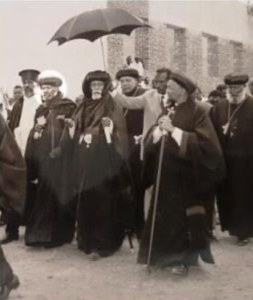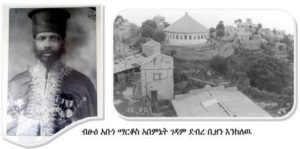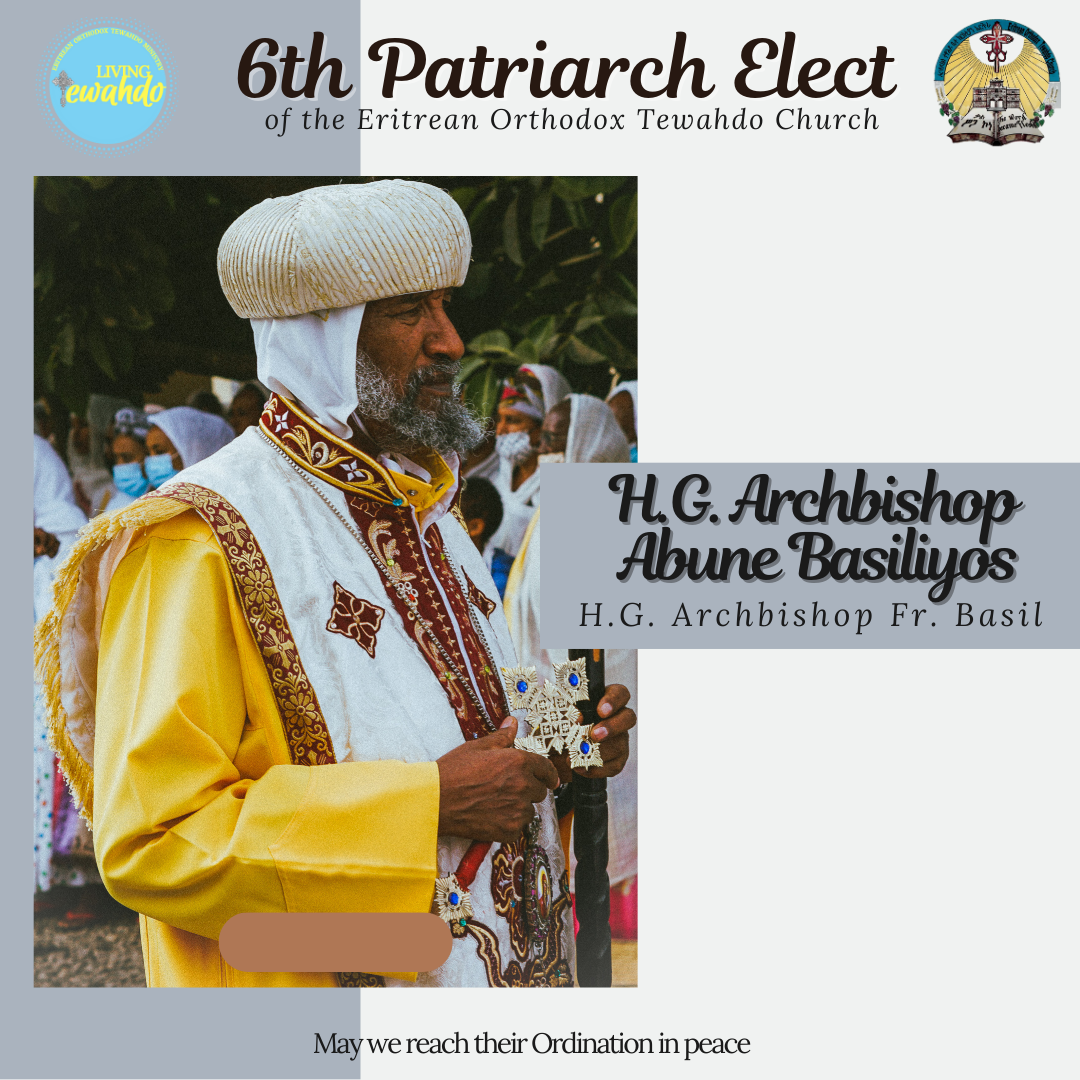In the name of the Father, the Son and of the Holy Spirit One God, Amen!
As the wise Solomon has said, ‘A good name is better than a precious perfume’ (Ecclesiastes 7:1 AMPC). A person with a good name lives through his/her spirit even after death. His/her story and name glows like diamonds and purls and their memories are unforgettable. November 30th 1937, eighty-two years ago marks the ordinationof His Grace Abunä Marqos, the first Eritrean Bishop.
His Grace Abune Marqos (Mark) is a bishop with a godly name and a wonderful history. His Grace is forever remembered even as his flesh lies in the ground beneath the soil, his story lives beyond the clouds. We remember his name over a decade later (59 years to be exact).
His Grace Abune Marqos was born from his father TesfaEgzie (meaning Hope of the Lord) and his mother Werqu (meaning Golden) on December 25th 1885. His Grace was born in zoba (zone) DekemHare- in the land of SesaH, and was given the name ‘Gibre-Amlak’ (meaning ‘the work of God’). He was the first child of his parents, hence the name, proclaiming ’this is the work of God’. When his grace was of age, he started attending a local church and got consecrated a deacon. Then, he headed to the monastery of Debre Kol Abune Buruk Amlak for his priesthood.
Later, his Grace decided to go to Gonder, Ethiopia to further pursue his knowledge in Qinie (a vital language teaching, as well as base of the Tewahedo faith introduction). On the day he decided to go, he received a vision that told him it was not the Lord’s will for him to go to Gonder at that time. Releasing it was not the Lord’s divine will, his Grace headed from Debre Kol Abune Buruk Amlak monastery to Debre Bizen.
As Abune Marqos was heading up the hill, he saw three elder monks with the same height and figure, they said to him, “Do not fear this is your habitation, a great grace and blessing shall be bestowed upon you!’ They blessed him and let him depart the rest of the journey to the monastery. Abune Marqos later realized the mystery they encountered was a sign for the lifetime they would spend at the monastery Debre Bizen.
Through his given grace our father spent his time serving the monastery and the monks. His service and commitment was noticeable. In 1907 at the age of 20 Abune Marqos became a monk, the fathers at the monastery confirmed, ‘It is upright for him!’ Abune Marqos was consecrated to the monastic life by the hand of Abune AmdeMaryam (Mary’s Pillar), headfather of Debre Bizen.
Even after been ordained a monk, his quest for the Lord’s words was still present. He continued to learn Qinie (a vital part of the Tewahedo faith, as well as linguistic purpose or for Ge'ez language teaching) from Teklehaymanot Welderufael. He took lessons on Ziema (Hymns of Yaredic melody) from Memhir GebreHiywet. Lastly, he learned Kidassie (Liturgical hymns) from Debre Abay Monastery and graduated earning Mezgebe Qiddase (the treasure of Liturgy). Right away, he started teaching liturgical hymns in Debre Bizen.
As he gained wisdom of the Lord’s words, his everlasting love for the monastery grew, he remained in Bizen and resumed his duties within. His Grace Abune Marqos overflowed with holiness, which lead him to be elected as a Headteacher of Debre Bizen and serve as such for many years. Later, he was also elected by Debre Bizen congregation to be a teacher of Debre Genet (Mount Eve) in Tigray (sub-region Adwa), a monastery under the care of Debre Bizen. As it is practiced by the Debre Bizen community, for one to be appointed Abbot/Abeminiet (Head Monk of a monastery), one must work his way up in Debre Genet (Mount Eve). This is for preparation of appraisal, service, administration, spiritual life, and improvement.
His Grace Abune Marqos, served in Debre Genet for a long time, preaching gospels, fulfilling monastical duties, and conducting financial developments. In January 1931, Abune Marqos were chosen to be Abbot (headfather) by the congregation of Debre Bizen when Abbot of Debre Bizen Abune AmdeMaryam passed away.
His Grace Abune Marqos was of a great mind, his words made believers, and he could come to an agreement with anyone. During his time, a time when Italy ruled, he made a lot of contributions to Debre Bizen. Some of which were;
- Got cereal grinder for the monastery delivered by Teleferico (a high transportation system and one of its kind).
- In the seaport of Massawa, in the midst of the sea by embedding steel and laying woods, in forty days (40 days) a church dedicated to the holy of holies St. Mary was built.
- Build an Orthodox parish in Segeneiti as well as in Sesah.
His grace commitment and struggle to keep the doctrine as well as the tradition of the Orthodox faith had him imprisoned, naming him, ‘SemaEt wengiel’ meaning, “Martyr of the Gospel.’
One day, an Italian visitor came to Debre Bizen monastery, and killed a gazelle with his ruffle. As known to all, a monastery is a sacred place of solitude for monks in which they engage in prayers, contemplation, prostration separated. Laughter, jokes, or speaking loudly are not permitted, nevertheless to shoot a gun. As soon as his Grace Abune Marqos heard the gunshot, he went outside and rebuked him, ‘Our monastery is not for hunters; nor a place for a shotgun to be heard!” He took his ruffle and sent him out.
Subsequently, he took the ruffle and headed to Asmara, where he talked to the Italian administration office bravely with respect to religious rights and returned the ruffle back.
His Grace tenure was remarkable, as he tried to introduce innovations intended to ease the harshness of monastic life. He installed a coal-operated mill, bought a number of houses for the monastery in Asmara and Mendefera. He tried to create a constant source of income for the community. He often travelled for preaching, particularly to Massawa. In 1933 his Grace travelled to Egypt with a number of candidates for priesthood, who were ordained as deacons and priests at his request.
His Grace Abune Marqos was an Abbot of Debre Bizen for seven years when it was time for the prophecy foretold Abba Tekle Alfa concerning ‘five bishops’ to be consecrated to happen. His great faith and amplitude mind was witnessed by all which lead him to be more exalted than others. In November 1937, at the feast of Zion, he was consecrated as the first Eritrean Bishop. Thus conforming the previous prophecy of being the first consecrated Bishop from Debre Bizen came to be.
When his Grace was consecrated Bishop of Eritrea and Tigray, he executed his duties free from racism and sectionalism. At the annual feasts (kbre Beal), his Grace gave a white robe (Sash: Ex.28:40; 29:6 KJV) to the psalters (Mezemran) and scholars of the church. His Grace was a lover of the poor, a helper to those in need, and this was witnessed many times. One of the deeds he is well known for is helping troubled ones, feeding the hungry, and quenching the thirsty.
His Grace’s love for his country was not comparable to any. He fought so that seaport Asseb is not ripped off and given to Ethiopia. His Grace went as far as to reach out to emperor Haile Silassie, to find a solution. Haile Silassie’s plan was to give it Welo diocese. By the Bishop of Welo, an inauguration was placed for consecration of a church, archbishops and tribunal were present. Seeing an inauguration placed by others, his Grace Abune Marqos stood bravely and said, “Asseb is not within your diocese!” Having demonstrated his objection, he left the inauguration, and started heading to Asmara. The rest of the congregation sent a message to emperor Haile Selassie saying, “His Grace Abune Marqos protested the inauguration and is heading to Asmara.” The emperor replied, “Quickly go now and return him; also let the inauguration be led by him!” They did as they were told. After these, his Grace said this to the inauguration he lead, “Asseb is a part of Eritrea not Welo’s!” His grace fought and stroked without a spear.
Since this incident, there were hardships between the clergy and the government. A decision was made to remove his Grace from the diocese of Asmara, and have him sent to Addis Ababa to live and to never return. His Grace did not leave Addis Ababa for two years.
But an incident happened that forced his Grace to leave. When his Holiness Pope Kyrillos of Alexandria (Egypt) finished his visit to Ethiopia, he was in desperate need of a bishop to accompany him through the port of Asseb. Pope Kyrillos was told, 'There was none who knew the roads better than his Grace Marqos, let him lead you.' His grace went to all the bishops individually and said his farewell. He accompanied his Holiness Pope Kyrillos Patriarch from Addis Ababa to Asmara. He continued his journey to Massawa individually, as he reached the lower part of Dengolo the vehicle he was in flipped over. His Grace was injured and taken to hospital Mekane Hiywet Orota in Asmara. On Wednesday November 7th, 1960, his Grace departed this world at the age of 77. At the moment of his passing all the hospital lights went out, but his grace’s room was still lit. Testimonies were given by the faculty members of the hospital who were providing care to his Grace, 'His grace’s room was shining with miraculous light.'
The relic of his Grace was taken from the hospital to head of Churches Mount Zion St. Virgin Mary (Riese Adbarat Däbrä Tsion Kidst Maryam). At the last prayer, from all the monasteries, clergymen and faithful congregations were present. The burial of his Grace, headed to the place where they grew up, their spiritual mother Debre Bizen. Escorted by clergy in vestments and congregations the journey started. At the time of the journey, to proclaim the sainthood of his Grace, doves laid like a cloud accompanying the journey from head of Churches Mount Zion St Mary to Bete Giyorgis (House of George).
When it was time for the burial, to give salute the governor order his troops a 36 round in his Grace’s memory, the soldiers got ready and pulled the trigger but no shots were fired, again and again they tried but all the ruffles froze. When the burial was completed, when the troops reached Nefasit, the frozen ruffles started to shoot. This was no mere incident, this is the lifetime struggle of his Grace that 'a shotgun sound should not be heard in the place of solitude life!'
Like the forefathers Abune Filipos, Abune Yohans, Abune Libanos, etc his Grace did other miracles as well. In the place of the accident in Dengolo, 25 Km from it water flow out. In this place water to flow out has not been seen nor heard. From the time of his Grace’s accident, an unexpected water came out and made a spring. For this reason that place is known as 'May Abun' meaning 'Abuna’s water' to this very day. His Grace’s sainthood was also seen as the spring healed many ill ones.
As Saint Paul wrote to the Hebrew saying, “Remember your leaders and superiors in authority [for it was they] who brought to you the Word of God. Observe attentively and consider their manner of living (the outcome of their well-spent lives) and imitate their faith (their conviction that God exists and is the Creator and Ruler of all things, the Provider and Bestower of eternal salvation through Christ, and their learning of the entire human personality on God in absolute trust and confidence in His power, wisdom, and goodness)” (Hebrew 13:7 AMPC). By this eternal words we are commemorating his Grace calling him “Abona (father)” even after 59 years. Remembering all his glorious life, his work to flourish the Orthodox faith, as well as his contribution to his country. His deeds are remembered everyday by those who were with him, fellow fathers, disciples, clergy members, people who witness his grace, etc,. As the past generation has passed his Grace’s story, we must keep it alive by sharing with the next generation as well.
“May his Grace’s blessing be with us all.”
Glory to God,
Dn. Mathiwos
Sources
“Biography of His Grace Abune Marqos (Mark)” by father Kinefergb Marqos
Encyclopaedia Aethiopica, volume III. P. 792a-b




